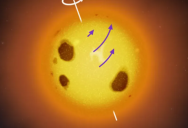Astronomers Discovered An Unexplained Rotation Pattern On A Sun-Like Star

Everyone knows that the Earth rotates in space, which is why we have the day and night cycle.
What many people may not realize, however, is that the sun is also rotating.
It takes about 25 days for the sun to complete one full rotation at the equator. At the poles, though, it takes about 34 days to complete a rotation, with lengths of time in between occurring at the mid-latitudes.
While interesting, it is not exactly surprising given that the sun is not made of rocky substances like Earth is.
Astronomers have looked at many other stars over the years, and while we can’t get as accurate of information due to their distance, most stars followed suit with rotation occurring slower at the equator and faster at the poles.

One star, known as V889 Herculis, looks like it is breaking the trend and scientists can’t (so far) figure out why.
A team led by Dr. Mikko Tuomi at the University of Helsinki have been watching this star for quite some time.
In fact, the university has been looking at it for over 30 years now.
This is because this star is similar in many ways to our sun, and relatively nearby at just 115 light years away. The difference that makes it interesting is that this star is only about 50 million years old, making it far younger than our own star.
Being able to study a younger version of our sun draws a lot of interest from astronomers.
The team led by Dr. Tuomi has recently looked at its rotation and found something interesting. At its equator it rotates every 32 hours, which is quite a bit faster than our sun.
At the poles, the rotation is quite a bit slower, with an overlapping occurring about every 150 days. Astronomers at the university have known this for quite some time.
What they found more recently, however was that at the rotation occurs fastest at 37-30 degrees latitude, which was very surprising.
Dr. Tuomi commented in a statement, saying:
“We applied a newly developed statistical technique to the data of a familiar star that has been studied at the University of Helsinki for years. We did not expect to see such anomalies in stellar rotation. The anomalies in the rotational profile of V889 Herculis indicate that our understanding of stellar dynamics and magnetic dynamos are insufficient.”

This finding will likely warrant some further investigation. It may even get the attention of astronomers around the world who have access to higher powered telescopes.
The one used to monitor this star is little better than what many people use in their backyards.
Tuomi also commented on this fact, which will hopeful inspire amateur astronomers to keep their eyes out for abnormalities in space.
“It is amazing that even in the era of great space-based observatories we can obtain fundamental information on stellar astrophysics with small 40cm [16-inch] ground-based telescopes.”
The more eyes on the sky, the more we can all learn.
If you thought that was interesting, you might like to read about a second giant hole has opened up on the sun’s surface. Here’s what it means.

Sign up to get our BEST stories of the week straight to your inbox.




